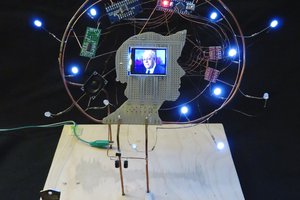This DNA shaped lamp is about 70mm high and 10mm large. It uses 12 smd leds and 24 smd resistors. Leds use 300 to 400mW, resistors waste about 450mW.
The idea for this DNA Lamp came when I was trying to reduce the price of a rainbow lamp I made. I thought of soldering the WS2811 directly to copper wire instead of using large PCBs.
The Rainbow Lamp is rather large (300mm width, 150mm high), but the tiny soldering of the WS2811 pads on the copper wire made me think of some more tiny and complex shape. The idea for the DNA Lamp was born, I later replaced the WS2811 with 0806 leds, because that looked better.
Because it is so tiny, I had to imagine, test and train tools and process to build it. It took lot (and lot) of time, but you should be able to build it in one afternoon after reading the project log.
The DNA shaped lamp is kind of magic when you finally manage to do it. But lot other shapes are really easier to build. Flower shaped one are the best result/complexity ratio I could make, and beginners may try it first.
 ftregan
ftregan
 (if you wonder how I soldered the leds, see my tutorial
(if you wonder how I soldered the leds, see my tutorial 







 Daniel Domínguez
Daniel Domínguez

 MakersBox
MakersBox
 Inne
Inne
hi! do you have pictures posted somewhere? XD